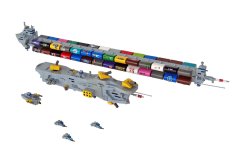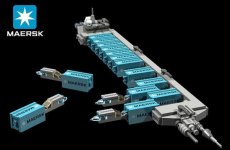Generally though, passenger modules don't show up in ACS in the OTU
Probably because no one considered/thought of the idea at the time the resources were being written/printed.
Think of it this way.
If you can put staterooms into
standard shipping containers (and by all accounts, you can!) then "containerized passenger services" simply require enough containers in a string with common access between them to make it all work.
10 staterooms = 8 high passengers + 1 steward + 1 medic = 40 tons
A "middleman" merchant line could do all the passenger gathering to fill the 8 high passenger slots and pay the steward and medic and life support costs for the lot. The containers just simply need to be shipped as 40 tons of standard cargo.
Overhead costs for 1 trip are ...
Cr 2000 * 10 = Cr 20,000 for life support for 10 staterooms
Cr 1500 + 1000 = Cr 2500 for crew salaries for 2 weeks for steward and medic
Cr 1000 * 40 = Cr 40,000 for cargo shipping of containers (the starship pays for berthing fees and fuel)
Revenue for 1 trip with 8 high passengers is ...
Cr 10,000 * 8 = Cr 80,000 for 8 high passage tickets
Net profit ... Cr 80,000 - 40,000 - 20,000 - 2500 = Cr 17,500 per trip for the "middleman" merchant.
If a starship has only a 40 ton cargo hold and can be chartered, transport costs drop from Cr 40,000 to Cr 36,000 ... raising net profit for the "middleman" merchant to Cr 21,500 per trip.
Not ridiculously lucrative, but that's just a single block of 40 tons of cargo capacity. The point though is that it's an "in" for extremely low end operators who can't even afford to buy/maintain a starship to get into the "interstellar passenger biz on the cheap" with an investment of MCr 7.4 (single)/MCr 5.92 (volume) to purchase the 40 tons of hull (configuration: 4) with 10 staterooms in them, which would require as little as MCr 1.48 (single)/MCr 1.184 (volume) down payment ... which is REALLY MODEST by starship standards.
So long as the "middleman" merchant line clears Cr 451,400 per year in net profit, they'll be able to break even including if operating under bank financing and needing to pay for annual maintenance (Cr 7400 per year) on single lot production from the shipyard (basically, a one off order).
17,500 * 26 = Cr 455,000 per year
By contrast, if such modules are already in steady volume production (MCr 5.92 per 40 tons with 10 staterooms), then the bank financing+annual maintenance (Cr 5920) fees means needing to clear Cr 361,120 per year which is a LOT more manageable.
17,500 * 21 = Cr 367,500 per year
Since the shipping containers themselves "never need to leave the starport" there's no 4 day shipping delay involved in getting them shipped to the starport for a new ship to take off with the passenger containers. Use the day after arrival at the starport to unload passengers and refresh all of the accommodations and life support systems. Give the steward and medic 2 days of shore leave ... so that by the 4th day everything is ready for passengers to arrive to embark, the containers are loaded onto the next outbound starship "going your way" and you're back into jumpspace for another week and another interstellar trip. So what you wind up with is a kind of 8 days jump time, 4 days planet time kind of cycle for ~12 days per trip.
12 * 30 = 360 days
So a "middleman" merchant running a starship-less interstellar passenger line with a single 40 block of cargo modules converted into 10 starship staterooms needs to make 21 trips per year with a full manifest in order to make a slight profit on a 40 year bank loan for volume production of these passenger modules ... and can make up to 29 trips per year and still have time for 2 weeks of annual maintenance and paid crew vacation time (during those 2 weeks). That means up to 8 trips per year at Cr 17,500 can be pure profit, which amounts to a profit margin of up to Cr 143,880 per year after all expenses are paid for (assuming full high passenger manifests on every trip). This may sound like "chump change" to most Fledgling Line merchant operators, but it's not nothing for a "mom 'n' pop" type of operation that essentially amounts to being interstellar hitchhikers as a business model, rather than needing to own and operate/maintain a starship themselves.
In other words, it's just yet another way to make a steady living if you aren't that inclined to be the adventurous/wandering Traveller type of sophont. You won't get rich quick just on passenger services ... but the potential Patrons you might meet ... well, that's a different adventure hook now isn't it?






